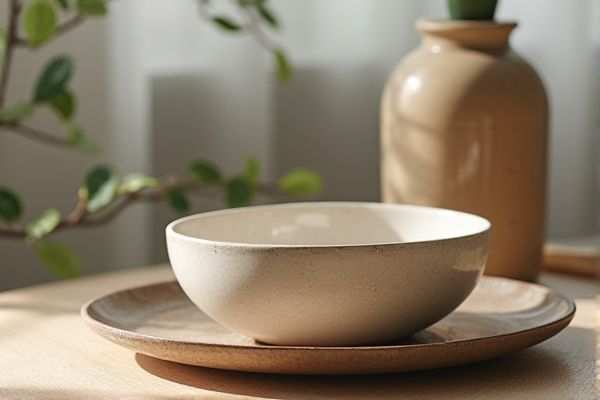
A decorative bowl enhances your space with artistic appeal and often serves as a centerpiece, while a storage tray prioritizes organization and functionality by keeping items neatly arranged and easily accessible. Discover how choosing between these options can elevate both the style and utility of your living area--read on to explore which suits your needs best.
Table of Comparison
| Feature | Decorative Bowl | Storage Tray |
|---|---|---|
| Primary Use | Enhances aesthetics, displays items | Organizes and holds multiple items |
| Shape | Round or oval, concave | Flat, rectangular or square |
| Material | Ceramic, glass, metal, wood | Wood, metal, plastic, fabric |
| Functionality | Primarily aesthetic | Functional organization |
| Size | Varies, generally shallow | Varies, generally larger surface |
| Placement | Tables, shelves, countertops | Desks, entryways, drawers |
| Typical Contents | Decorative items, keys, fruit | Office supplies, mail, small tools |
Introduction: Decorative Bowl vs Storage Tray
Decorative bowls enhance interior aesthetics with artistic designs and vibrant colors, serving as focal points on tables or shelves. Storage trays prioritize functionality, offering organized spaces for holding keys, mail, or small items while maintaining an orderly environment. Selecting between a decorative bowl and storage tray depends on balancing visual appeal with practical storage needs.
Defining Decorative Bowls
Decorative bowls serve primarily as aesthetic accents crafted from materials like glass, ceramic, or metal, often featuring intricate designs or vibrant colors to enhance interior spaces. They prioritize visual appeal over functionality, making them ideal for showcasing potpourri, fruit, or ornamental objects. Unlike storage trays, decorative bowls typically lack compartments and handle designs, focusing instead on form and artistic expression.
Understanding Storage Trays
Storage trays offer versatile functionality by combining organizational efficiency with aesthetic appeal, making them essential for decluttering spaces such as kitchens, bathrooms, and offices. Unlike decorative bowls primarily designed for display, storage trays provide flat, compartmentalized surfaces that accommodate multiple items, enhancing accessibility and order. Materials like wood, metal, and acrylic add durability and style, while features such as handles or raised edges improve portability and prevent items from slipping.
Key Differences in Functionality
A decorative bowl primarily serves as an aesthetic centerpiece, enhancing the visual appeal of your space with artistic designs and materials. In contrast, a storage tray offers practical organization, providing flat surfaces and compartments to neatly hold various items like keys, mail, or accessories. Understanding these key differences in functionality helps you choose between style-focused decor and efficient storage solutions for your home.
Aesthetic Appeal: Which Enhances Decor?
Decorative bowls enhance decor with their artistic shapes, vibrant colors, and sculptural qualities, often acting as focal points on tables or shelves. Storage trays prioritize functionality with compartmentalized designs, but can also feature sleek materials like wood, metal, or acrylic that add subtle elegance to a space. For maximizing aesthetic appeal, decorative bowls offer more visual interest and artistic flair compared to the typically utilitarian look of storage trays.
Versatility in Use: Bowl or Tray?
Decorative bowls offer versatile use by enhancing aesthetic appeal while serving as containers for fruits, potpourri, or small items. Storage trays provide an organized surface ideal for corralling keys, mail, or office supplies, making them practical for entryways and desks. Choosing between a bowl and a tray depends on whether you prioritize visual elegance with multi-functional storage or streamlined organization with accessible layout.
Materials and Design Options
Decorative bowls are typically crafted from materials such as glass, ceramic, or wood, offering a wide range of artistic designs that emphasize aesthetics and visual appeal. Storage trays, on the other hand, often utilize durable materials like metal, plastic, or bamboo, designed with functionality and organization in mind, featuring compartments or raised edges for securing items. Your choice between the two depends on whether you prioritize stylish accents or practical storage solutions in your space.
Space-Saving and Organization Benefits
Decorative bowls and storage trays both enhance space-saving and organization but serve different purposes. Decorative bowls offer a stylish way to keep small items like keys and jewelry easily accessible while adding visual appeal to your space. Storage trays maximize organization by compartmentalizing belongings such as remote controls, office supplies, or makeup, making it easier to maintain a clutter-free environment.
Ideal Rooms for Each Choice
Decorative bowls are ideal for living rooms and dining areas where they serve as eye-catching centerpieces or accent pieces, enhancing the room's aesthetic appeal with their artistic design. Storage trays are best suited for entryways, kitchens, or offices, providing practical organization for keys, mail, or office supplies while keeping surfaces tidy. Choosing between a decorative bowl and a storage tray depends on whether the primary goal is visual appeal or functional storage in the specific room.
Conclusion: Choosing the Right Accessory
Decorative bowls elevate interior aesthetics with artistic designs and are ideal for displaying small objects or enhancing table centerpieces, while storage trays offer practical organization for everyday items like keys, mail, and remote controls. Selecting the right accessory depends on whether the primary goal is visual appeal or functional storage, aligning with room purpose and personal style. Incorporating both elements can balance beauty and utility, optimizing space and decor cohesively.
 homyna.com
homyna.com